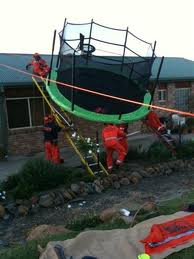Trampolines are now a very popular feature of many gardens but how much thought is applied to where they are best positioned? In this article I aim to cover the main points that need to be considered when siting your garden trampoline both for the safety of those using it and to prolong the life of the trampoline itself.
Buy the right size trampoline
The trampoline should be age appropriate in size for your child. It is generally accepted that a full size trampoline of 6ft or larger is only appropriate for children of 6 years and above. Next consider the space you have available and measure it to check. The total diameter of a round trampoline is the size. You should ensure you have at least 2.5m of clear space all around the trampoline. If you are using an enclosure this can be reduced say to around 1m. Do not position the trampoline directly against a fence, a garden wall or the side of the house. There needs to be a good gap.
Not on a slope
Trampolines are designed to be installed on level ground. If the trampoline is on a slope the bouncer will gravitate to the lower edge of the trampoline. This can be both dangerous and mean the bouncer does not use the optimum position to get most power as they bounce. Try to get the trampoline as level as you can. If the ground has a slight incline or is uneven then you can create small channels in the soil to sink the legs slightly where necessary. Note that it is only the bottom of the leg frames which need to be on even ground so you may find you can minimise the leveling work required by turning the trampoline slightly. If the slope is too severe then you may need to cut out a terrace to give a flat area.
On soft ground
Ideally the trampoline should be on soft ground to absorb the impact energy. Probably the best surface is bark or similar as this is soft and energy absorbing, will provide good drainage and supress any weeds. There is also no need for grass cutting underneath. You should avoid hard surfaces like concrete or tarmac. If these are the only possibility then a safety enclosure is a must and try to place some soft matting around the entrance area to the trampoline. You will also need some rubber feet to put under the U shaped legs of the trampoline to absorb the impact energy. If you are putting the trampoline on grass bear in mind you will need to move the trampoline to cut the grass underneath it.
Clear air space above
Make sure that the trampoline is not put under a tree where leaves and bird droppings will fall on it. It may also interfere with enthusiastic bouncing. You also need to be clear of overhead cables and washing lines.
Clear surrounding space
The area around the trampoline needs to be kept clear of fixed equipment like swings, climbing frames, sheds fences and walls. This also applies to mobile equipment like bikes and toys. Ideally there is a 2.5m clear gap around the trampoline, although slightly less is acceptable if you have a trampoline with enclosure.
Far away from swimming pools and ponds
You need to keep well clear of swimming pools, ponds and paddling pools. Don’t risk a child falling from the trampoline into water. And avoid any temptation children may have to jump from the trampoline into the water by siting the trampoline well away.
Not an exposed position
Although the trampoline is a heavy piece of equipment, the safety enclosure can act as a sail and causes lots of windage. The mat also acts like a sail and in a strong wind the trampoline will lift off the ground. Make sure the trampoline is in an area protected from the prevailing wind and also use a trampoline anchor to keep it secure. If your site is extremely exposed then pay particular attention to secure the whole frame to the ground and not just the U shaped legs as these can become detached from the main trampoline frame allowing that part to be blown away leaving the leg frames secured to the ground.
Within sight of the house
You need to keep an eye on your children whilst they are using the trampoline to ensure they are not doing anything dangerous. It might be helpful to place the trampoline within sight of the kitchen or lounge windows which will make this a little easier for you.
Easy to move (if necessary)
If you are positioning the trampoline on grass you will want to move it now and then so you can mow the grass and to allow the grass to recover. Although the trampoline mat will let through some light and water it will reduce it so the grass underneath will suffer if the trampoline isn’t moved from time-to-time.
If sinking it to ground level – good drainage and soil depth
Some people decide to sink their trampoline into the ground so the mat is at ground level. This avoids the need for a trampoline enclosure. A separate blog post covers this but you need to ensure the site has good drainage and an adequate depth of soil to allow you to dig a hole of sufficient depth to sink the trampoline to ground level.
Good area of soft ground around the entrance
Make sure the area around the entrance to the trampoline is soft ground or has play mats. Children may forget to close the entrance to the trampoline and there is always the risk they might bounce out. The Atlantic Trampolines have an easy to close zip but some makes have a more complicated toggle system which children will not take the time to close-up.
These are all the main points to consider when deciding where to put your garden trampoline. If you have any comment then please send them to us by clicking on the link below.
Author: Bob Bounce



Pingback: Gardeners' Question Time - What to plant under a trampoline? | Atlantic Trampolines Blog